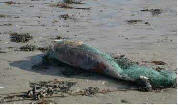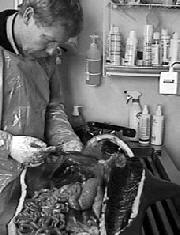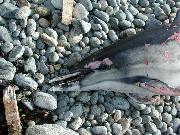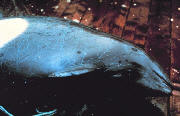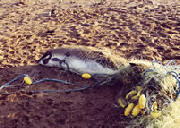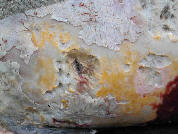EUROPEAN CETACEAN BYCATCH CAMPAIGN
"Man is but a strand in the complex web of life"
"Man is but a strand in the complex web of life"
Cetacean Bycatch
Bycatch is the incidental capture of non-target species, in any fishery.
Bycatch poses the most serious threat to dolphins, porpoises and whales.
Cetaceans are protected under the Bern, Bonn (ASCOBANS), and Biological Diversity
Conventions, the Habitats and Species Directive (92/43/EEC) and are treated as having Appendix I Status CITES, within the European Union. In the UK, they are protected under the Wildlife and Countryside Act, the Conservation Regulations, and the Countryside and Rights of Way Act.
There are laws and regulations which prohibit the harassment, abuse and killing of porpoises, dolphins and whales.
However, the fishing industry defies all the conventions, regulations, and laws under which cetaceans are protected, and appears to be immune from prosecution.
Tens of thousands of cetaceans are dying in fishing nets each year. They become entangled in tangle nets, trammel nets, drift nets, trawl nets, gillnets and long lines.
The true extent of the bycatch problem is not known, as many fleets prohibit observers from boarding their vessels.
However, studies that have been carried out, show that the problem is of monumental proportions.
A study of the French albacore tuna drift net fishery 1992 - 1993 (when only 27% of the effort was observed) showed an annual bycatch of 415 common dolphins and 1170 striped dolphins.
In 1995, a study of the UK tuna drift net fishery (when only 28% was observed) revealed that the annual bycatch of dolphins was TWICE that of the French. These drift net fisheries are supposed to be phased out by 2002, but, the powerful tuna fishing lobby, plans to seek a ruling from the European Court to maintain tuna drift net fishing.
Studies have estimated that the annual bycatch of harbour porpoises in the Celtic Sea hake gillnet fishery, is of the order of 2237 individuals, but this estimate does not include the bycatch from any UK boat under 15 metres in length, any Irish boat under 10 metres, any of the French boats, or any of the tangle net boats. Neither does it include a proportion of bycaught porpoises which disentangle from the net during hauling, that are already dead. It is estimated that 6785 harbour porpoises are caught in Danish North Sea gillnet fisheries each year, and 1000 in the UK North Sea gillnet fisheries.
Many thousands of cetaceans are killed in trawl nets annually, including minke and pilot whales.
The trawlers which cause the greatest problem are pelagic (mid water) trawlers.
Available information suggests that potentially high numbers of common, white-sided and striped dolphins are being killed in trawl fisheries in the North East Atlantic each year. Further estimates suggest that up to 50 dolphins may be taken in a single tow by the Irish pelagic trawlers.
The most destructive of all pelagic trawlers, are the pair trawlers.
The Scottish, French and Dutch pair trawlers tow nets of gigantic proportions. They are so large that 12 jumbo jets could easily fit inside one net. It is estimated that in a six week period at the beginning of this new millennium, in excess of 2000 dolphins died in the nets of French and Scottish pair trawls alone.
It is estimated that 6.2% of the total population of harbour porpoises in the Celtic Sea is killed each year in fishing nets, and 4% of the total population of harbour porpoises in the North Sea. The International Whaling Commission has stated that a continual kill rate of only 1% of a cetacean population, will render it non-sustainable.
The result of this death and destruction is often seen on European beaches. A small proportion of bycaught cetaceans are found around the coasts of the UK, Eire, France, Belgium, Holland, Portugal, Spain and so on.
February 1989: 600 dolphins stranded in two days in Landes and Vendees, France.
January - April 1992: 118 dolphins (of which nearly half were positively identified as common dolphins) stranded in Devon and Cornwall - the vast majority showing signs of bycatch; in 1993, 20 common dolphins; 1996, 30 common dolphins. This pattern was mirrored on the coastlines of other European countries.
February - March 1997: in a three week period 629 dolphins stranded on the Southern Brittany and Biscay coasts.
February - March 2000: in excess of 600 dolphins stranded on the coasts of Cornwall, Devon and Brittany.
Of the stranded cetaceans post mortemed by veterinary surgeons at the Institute of Zoology in London1 1990 - 1997,
34.4% of harbour porpoises were found to be bycatch
60.4% of common dolphins were found to be bycatch
11.6% of other whales and dolphins were found to be bycatch.
39.8% of all cetaceans were found to be bycatch.
(These figures are likely to be an underestimate, as a cause of death could not be established for nearly a quarter of all those post mortemed).
Of the stranded cetaceans post mortemed by veterinary surgeons at SAC Veterinary Science Division, Inverness2, 1995 - 1999,
15.4% of harbour porpoises were found to be bycatch
11.7% of white-sided dolphins were found to be bycatch
16.7% of bottlenose dolphins were found to be bycatch (caught in illegally set nets)
40.0% of Risso's dolphins were found to be bycatch
40.0% of minke whales died as a result of entanglement in fixed ropes, such as creel or mooring ropes.
The physical evidence of entanglement in fishing nets or gear are:
Gillnets, trammel nets, and tangle nets: lacerations on the head, body, fins and tail fluke caused by the net;
penetrating wounds, often in the lower jaw and head area, made by gaffs used by fishermen to remove the cetaceans from the net;
broken bones; broken teeth;
internal haemorrhage and signs of asphyxiation.
